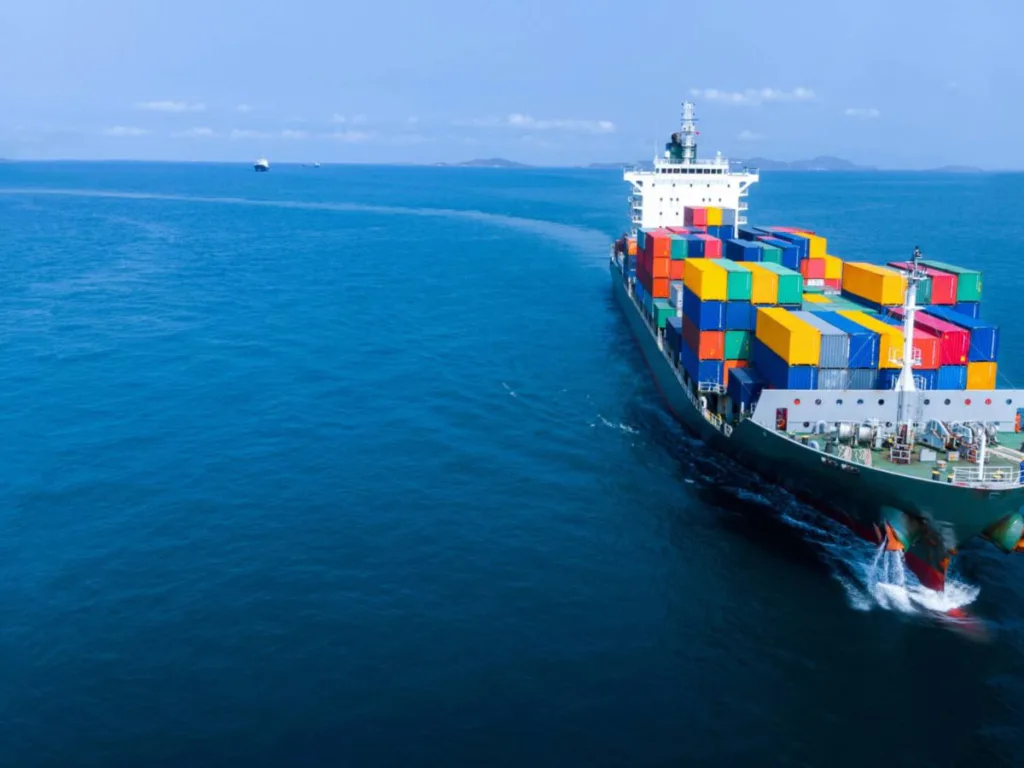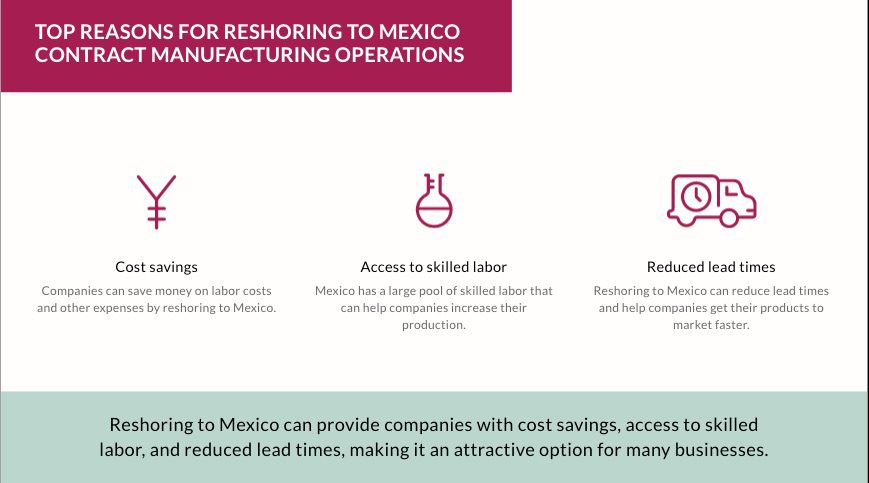Last Updated on April 1, 2024

A growing number of global companies have begun reshoring manufacturing operations to Mexico in recent years. The phenomenon of reshoring, or bringing production home from overseas locations to domestic or nearby markets, presents a compelling opportunity for companies aiming to optimize their supply chains. This will reduce costs and increase operational efficiency. This article explores the dynamics and advantages of the phased reshoring of manufacturing back to Mexico. It sheds light on its implications for businesses and the broader economy.
What Is Phased Reshoring of Manufacturing?
Phased reshoring of manufacturing refers to a strategic approach to bringing goods production back to a home country (often the US) from overseas locations in a gradual and well-planned manner. It contrasts with the more abrupt and potentially risky approach of complete reshoring.
Key Characteristics of Phased Reshoring
Gradual process: Instead of immediately shifting all production back home, companies implement reshoring in stages, starting with less complex components or products and gradually scaling up as they refine their processes and address any challenges.
Focus on feasibility: Each phase carefully evaluates the feasibility of reshoring based on factors like cost, quality, logistics, and talent availability. This allows companies to identify potential roadblocks and mitigate risks before investing heavily.
Data-driven decisions: Data plays a crucial role in planning and executing each phase. Companies analyze cost structures, supplier performance, and market trends to make informed decisions about which products or processes to reshore. They also optimize their supply chains.
Technological adoption: Utilizing automation and advanced manufacturing technologies helps companies overcome cost disadvantages associated with domestic production and compete effectively with overseas producers.
Understanding the Shift of Reshoring of Manufacturing Back to Mexico
The shift of manufacturing operations back to Mexico is a complex and multifaceted phenomenon with various driving forces and potential implications. Here's a breakdown to help you understand it better:

Motivations for Reshoring to Mexico
- Rising costs in traditional hubs: Labor costs in China, a major manufacturing hub, have steadily increased, making Mexico a more cost-competitive product outsourcing option for some goods.
- Trade tensions and geopolitical risks: The ongoing trade war between the US and China, coupled with global political instability, has prompted companies to diversify their supply chains and reduce reliance on single-source countries.
- Improved infrastructure and workforce: Mexico has invested in infrastructure upgrades and workforce development programs, making it a more attractive destination for manufacturers.
- Free trade agreements: The USMCA (United States-Mexico-Canada Agreement) facilitates trade between the three countries and lowers tariffs, further incentivizing reshoring to Mexico.
Advantages of Reshoring to Mexico
- Proximity to Market: By relocating manufacturing operations to Mexico, companies can capitalize on the country's close proximity to the lucrative U.S. market, facilitating faster delivery times and reduced transportation costs.
- Cost Efficiency: While labor costs in Mexico may be higher compared to some offshore destinations, they remain competitive relative to other North American markets. Additionally, savings in transportation expenses and inventory holding costs contribute to overall cost efficiency.
- Quality Control: Closer proximity allows for more effective oversight and quality control measures, enabling companies to uphold stringent production standards and mitigate risks associated with offshore manufacturing.
- Strengthening brand image and reputation: Producing goods domestically can resonate with consumers who value local manufacturing and social responsibility.
- Strengthened US-Mexico relations: Increased economic interdependence fosters closer collaboration and cooperation between the two nations.
Reshoring also benefits manufacturing companies by potentially reducing the total cost of their products, improving balance sheets, and making product innovations more effective. While many of these supply chains can operate less expensively in Asia, the COVID-19 crisis has underlined the societal risks of leaving this production offshore.
Brookings Institute
Phased Reshoring of Manufacturing: Advantages and Disadvantages
Phased reshoring of manufacturing back to North America offers several key advantages over doing it all at once:
- Manageable Transition: Phased reshoring allows companies to manage transition processes more effectively. By gradually bringing manufacturing back to North America, businesses can address logistical, operational, and supply chain challenges in a controlled manner. This approach reduces the risk of disruptions and minimizes potential setbacks from abrupt changes.
- Resource Optimization: Companies can optimize resources more efficiently during phased reshoring. They can allocate financial, human, and technological resources gradually, ensuring that each phase of the reshoring process receives adequate attention and investment. This enables businesses to adapt to evolving market conditions and address unforeseen challenges effectively.
- Risk Mitigation: Phased reshoring mitigates risks associated with large-scale operational changes. By implementing reshoring initiatives in stages, companies can identify and address potential risks early in the process. This proactive approach enables businesses to implement appropriate risk mitigation strategies and safeguards, reducing costly disruptions and delays.
- Stakeholder Alignment: Phased reshoring allows companies to align stakeholders more effectively. By involving key stakeholders, including employees, suppliers, customers, and investors, throughout the reshoring process, businesses can foster effective collaboration, transparency, and buy-in. This alignment enhances organizational cohesion and support, facilitating smooth transitions and long-term success.
- Continuous Improvement: Phased reshoring promotes continuous improvement and optimization. By periodically evaluating and adjusting reshoring strategies based on performance metrics, market dynamics, and stakeholder feedback, companies can enhance operational efficiency, quality, and competitiveness over time. This iterative approach enables businesses to adapt to changing circumstances and capitalize on emerging opportunities more effectively.
Challenges and Considerations
While reshoring offers compelling advantages, it also presents challenges such as initial investment costs, logistical complexities, and workforce training requirements.
- Higher initial costs: Setting up domestic production can be expensive, requiring investments in infrastructure, talent development, and technology.
- Competition from established overseas producers: Reshored businesses may face competition from well-established manufacturers in low-cost countries.
- Talent availability: Finding skilled labor in specific sectors can be challenging, especially in regions with declining manufacturing activity.
Conclusion: The Reshoring of Manufacturing to Mexico Is a Strategic Imperative
The phased reshoring of manufacturing back to Mexico represents a strategic imperative for businesses seeking to optimize their supply chains and mitigate risks associated with offshore production. By leveraging Mexico's proximity, skilled workforce, and operational advantages, companies can enhance agility, reduce costs, and drive sustainable growth in an increasingly competitive global marketplace.
Phased Reshoring of Manufacturing FAQs
1. What factors are driving the trend of reshoring manufacturing back to Mexico? The trend is driven by rising labor costs overseas, supply chain disruptions, and a growing emphasis on proximity to consumer markets, among other factors.
2. How does reshoring to Mexico contribute to cost efficiency? Reshoring to Mexico enables companies to capitalize on cost savings from reduced transportation expenses, inventory holding costs, and proximity to the U.S. market.
3. What challenges may companies face during the transition to reshoring? Challenges include initial investment costs, logistical complexities, and workforce training requirements, which can be mitigated through strategic planning and collaboration.
4. How can companies navigate the phased approach to reshoring effectively? Companies can navigate the phased approach by conducting thorough assessments, engaging stakeholders, and developing robust transition plans aligned with strategic objectives.
5. What are the long-term implications of reshoring manufacturing back to Mexico? Long-term implications include enhanced operational efficiency, improved supply chain resilience, and sustainable growth opportunities for businesses operating in the region.
About NovaLink
As a manufacturer in Mexico, NovaLink employs a unique approach that transcends the traditional model of shelter production. More than just the location of your manufacturing, we would like to become a partner in your manufacturing in Mexico. You will be able to relocate or initiate manufacturing for your company in Mexico in a low-cost labor environment with very little delay or up-front costs. Find out how we can help you by handling the manufacturing process.
There are NovaLink facilities in the border cities of Brownsville, Texas, Matamoros, Mexico, and Saltillo, Mexico.
Explore More: Discover Related Blog Posts
Expand your knowledge and delve deeper into more information about investing in Mexico manufacturing with our curated collection of related blog posts.
- Mexico Rewards Manufacturing Companies That Commit: Here’s Why
- Can Moving Manufacturing to Mexico Really Be Turnkey? Here’s What You Need to Know
- How U.S. Tariffs Are Reshaping Mexico’s Manufacturing Outlook
- 3 Key Benefits of Operating in Mexico’s Border Zone
- Mexico’s Infrastructure: A Key Factor in Outsourcing Decisions
- Tax Incentives and Economic Zones for Manufacturers in Mexico
- Mexico’s Industrial Manufacturing Sector Opportunities for Foreign Investment
- Setting Up an Industrial Manufacturing Facility in Mexico: A Smart Business Move